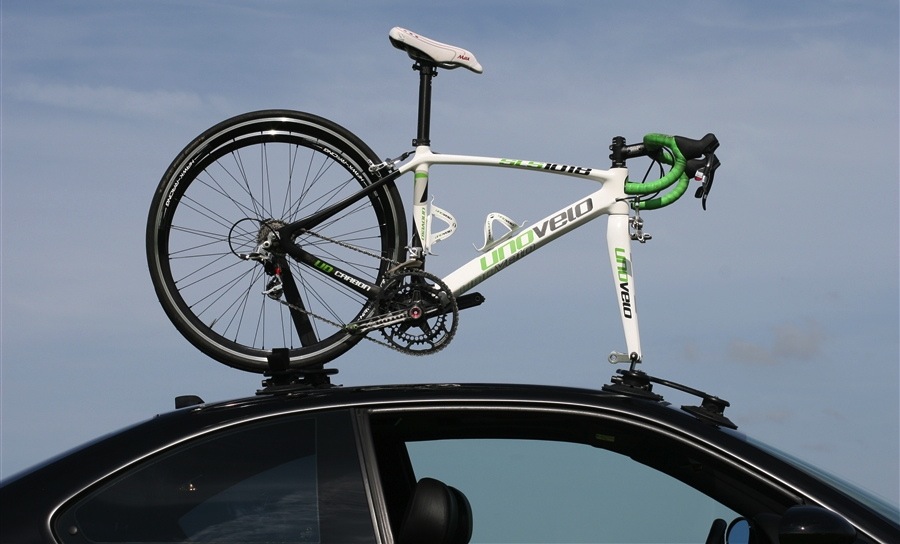
By Cid Cardoso, Jr.
Once in a while, we see a product and our reaction is “What the %#@&?” The SeaSucker Bike Rack is such a product. Have any of us seriously considered attaching our beloved (and often quite pricey) bikes to the roof of our cars by what looks like oversize suction cups? Not in a million years. Or at least not until now – and even now it will most likely take some serious convincing, a lot of research, credible testimonials from friends and still a certain amount of faith. I must admit I was initially skeptical, but now I’m a convert.
SeaSucker Bike Racks are made by a Florida-based company called SeaSucker. They use their “SeaSuckers” (think octopus), or pump-style vacuum cups, to create mounts that are surprisingly easy to use and yet amazingly strong, therefore offering incredible versatility. Note that these cups are vacuum cups, not suction cups. The manufacturer is quick to point out that there is a big difference, but I had to do some additional research to find their definitions.
According to www.deltakits.com, Vacuum Cup Lesson 101, suction cups are cup-shaped devices, usually made of rubber, silicone or other flexible compounds, that use negative fluid pressure of air or water to adhere to nonporous surfaces and in the process create a partial vacuum. Vacuum cups are also typically made of rubber, silicone or other flexible compounds, but unlike suction cups, feature a lever, button or pump that pulls the center of the cup up away from the glass, thereby creating a vacuum that holds the outer edges of the cup securely to the mounting surface. A vacuum cup is generally flatter, allowing more surface area to contact the glass, thus providing a more secure attachment with very little downward pressure regardless of the cup size. Attached properly, vacuum cups are also typically far more rigid than suction cups. The way my layman brain interpreted all this is that vacuum cups essentially create a much stronger hold.
SeaSuckers got their start in the marine accessory business in 2005 as they developed a way to attach a chair to a boat deck by using vacuum technology. They claim they never sold the chair model, but in the process stumbled onto a unique and effective way to attach rod holders, dive racks, cup holders, etc., to boats. This eventually led to the idea to attach bike racks to the different cars and different areas of cars without the hassle of permanently attaching any hardware.
My first question was whether there is a need for such a product. With so many other hitch-, trunk- and roof-mounted racks by such well-known companies as Yakima, Thule and Saris, why do we need vacuum-mounted racks? Looking cool and being different is not a good enough reason for me. But as I found out with my current minivan, many vehicles that used to include factory roof racks now no longer do, in order to keep the lines more stylish and get better gas mileage (these may be installed at the car dealership for around $350). In addition, as body styles change, rack manufacturers struggle to keep pace with products that will fit the new roof lines.
When I got my van, Yakima and Thule didn’t even make parts that would fit the new Odyssey. So if you prefer roof racks over rear-mounted ones, as I do (since I seem to use the rear hatch door quite a bit with three kids and all their equipment), the SeaSucker Bike Rack is the perfect solution. Also, the fact that I can use the same rack on any vehicle, whether a minivan or a sports car, without having to purchase additional parts is definitely appealing to me.
Additionally, the SeaSucker Bike Rack creates a lot of possibilities for cyclists. Installation is so simple and the pieces so compact (as compared with other options) and light (about 6 pounds for the one bike rack) that they are easy to travel with. You can fit the parts in a small bag and use it on a rental car across the country if you decide to either take the bike or rent one at the next trip. Finally, as mentioned before, the ease of installation and removal allows you to decide when to keep it on the vehicle and when to remove it.
The website www.greencarreports.com determined that a 2.4-cylinder vehicle with an automatic transmission experienced a drop of 5 miles per gallon when a roof rack alone (without a bike) was added. In forums, individuals reported a drop of 2 to 6 miles per gallon when a roof rack without a bike was added to their vehicles. This can be a difference of as much as $800 per year based on 15,000 miles driven.
SeaSucker Bike Racks utilize 6-inch vacuum cups to attach a fork mount and a separate 6-inch cup to attach the rear-wheel mount/strap. Each cup has a visible button that when pressed repeatedly pumps out or removes the air from the cup, thus creating a vacuum. The button, which has a white mark on it, also acts as a gauge that allows the user to clearly see when the cup is losing pressure and needs to be re-pumped. A lubricating solution is included to help clean the contact surface and to create a better seal. The single bike rack, called the Talon, uses 3 cups for the fork mount, while the 2-bike rack option, called the Mini-Bomber, uses 4 and the 3-bike rack option, called the Bomber, uses 5.
A separate cup is used for each bike to secure the rear wheel. Each cup is rated with 210-pound pull strength and the single bike rack can carry up to 45 pounds, which is enough for practically every bike in the market. The body of the fork mounts is strong enough to hold the bikes in place and still flexible enough to accommodate the contour of roof lines, windshields, etc. The racks are designed to mount primarily on the roof and front windshield but can attach to virtually any surface, including trucks and rear windows.
So, does it work? Yes, the rack works as advertised. I found the rack to be simple, light and easy to install. When it came time to put my bike on top and drive around, I must admit I was at first not confident. I had seen the pictures on the website of a guy hanging onto a bike attached to the rear of an SUV and watched the videos of a NASCAR driver going around the track with a bike on top at 100 mph, but now we were talking about MY bike.
I installed the rack and drove around town for a couple of days, always checking the button/gauge. Everything was secure, so I then took it on the interstate to Topsail Beach. Once again the rack performed flawlessly. Next, I made the drive from Topsail to Charlotte, which involved five hours of torrential rain and strong gusts of wind. I kept checking the gauge at periodic stops and again I experienced no problems. By the time I drove to Lake Lure a few weeks later I was convinced. The cups will stick and the bike will be as safe as on any other roof rack.
As much as I liked the SeaSucker Rack, it does have a couple of limitations, or at least a few things to be aware of. The vacuum cups need to be re-pumped fairly regularly. With my Talon Rack, for some reason I kept having to pump one cup every day (maybe because I didn’t clean that area of the roof as well), while the other three cups I could go a couple of days without pumping them. I believe that this is the kind of thing that should be checked very regularly, and definitely every time a bike is mounted on top. The rack also does not lock to the vehicle. SeaSucker makes a “cable anchor” for the windows and trunk that allows the user to securely connect a cable loop to the car. This secures the bike but not necessarily the rack. I suppose that you could also lock the front fork skewer, thereby locking the rack to the bike. Still, when the bike is not on the rack and the rack is mounted on the car, it could easily be removed. This has not been an issue in Cary, N.C., but in my hometown of Sao Paulo, Brazil, the rack would likely not last a day.
The SeaSucker is without a doubt a very unique and useful bike rack. I now keep mine inside the vehicle and use it as needed. I like the simplicity and the fact that it’s not so permanent. SeaSucker Bike Racks are not the cheapest bike racks out there, starting at $270, but when compared with other roof racks, and with additional vehicle expenses to make other racks work, such as hitches and factory racks, they are not out of line. As cars become more aerodynamic and often smaller to deal with rising gas prices, cyclists will need to look for less conventional bike racks to transport their bikes. The SeaSucker Bike Racks should be at the top of the list.







